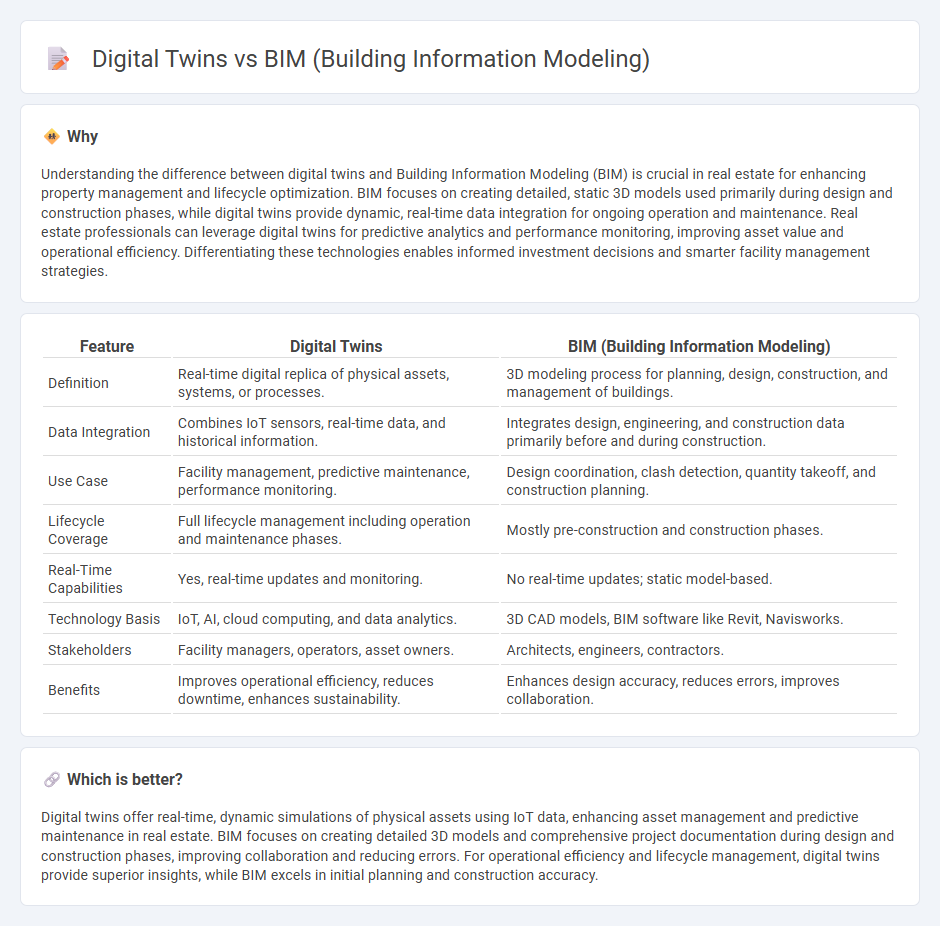
Digital twins create dynamic, real-time digital replicas of physical properties, enabling continuous monitoring and predictive maintenance in real estate. BIM focuses on detailed, static 3D models used primarily during the design and construction phases to improve planning accuracy and collaboration. Explore how integrating digital twins and BIM can revolutionize property management and development efficiency.
Why it is important
Understanding the difference between digital twins and Building Information Modeling (BIM) is crucial in real estate for enhancing property management and lifecycle optimization. BIM focuses on creating detailed, static 3D models used primarily during design and construction phases, while digital twins provide dynamic, real-time data integration for ongoing operation and maintenance. Real estate professionals can leverage digital twins for predictive analytics and performance monitoring, improving asset value and operational efficiency. Differentiating these technologies enables informed investment decisions and smarter facility management strategies.
Comparison Table
| Feature | Digital Twins | BIM (Building Information Modeling) |
|---|---|---|
| Definition | Real-time digital replica of physical assets, systems, or processes. | 3D modeling process for planning, design, construction, and management of buildings. |
| Data Integration | Combines IoT sensors, real-time data, and historical information. | Integrates design, engineering, and construction data primarily before and during construction. |
| Use Case | Facility management, predictive maintenance, performance monitoring. | Design coordination, clash detection, quantity takeoff, and construction planning. |
| Lifecycle Coverage | Full lifecycle management including operation and maintenance phases. | Mostly pre-construction and construction phases. |
| Real-Time Capabilities | Yes, real-time updates and monitoring. | No real-time updates; static model-based. |
| Technology Basis | IoT, AI, cloud computing, and data analytics. | 3D CAD models, BIM software like Revit, Navisworks. |
| Stakeholders | Facility managers, operators, asset owners. | Architects, engineers, contractors. |
| Benefits | Improves operational efficiency, reduces downtime, enhances sustainability. | Enhances design accuracy, reduces errors, improves collaboration. |
Which is better?
Digital twins offer real-time, dynamic simulations of physical assets using IoT data, enhancing asset management and predictive maintenance in real estate. BIM focuses on creating detailed 3D models and comprehensive project documentation during design and construction phases, improving collaboration and reducing errors. For operational efficiency and lifecycle management, digital twins provide superior insights, while BIM excels in initial planning and construction accuracy.
Connection
Digital twins integrate with Building Information Modeling (BIM) by utilizing BIM's detailed 3D models and data to create dynamic, real-time digital replicas of physical properties. This connection enhances property management, construction monitoring, and predictive maintenance through continuous data updates and analysis. Utilizing BIM data, digital twins improve decision-making processes and optimize building lifecycle management in real estate.
Key Terms
Data Integration
BIM (Building Information Modeling) emphasizes creating accurate 3D models enriched with detailed construction data to streamline project design and execution. Digital twins extend BIM by integrating real-time sensor data and operational analytics, enabling continuous monitoring and predictive maintenance throughout the building lifecycle. Explore the evolving role of data integration in optimizing infrastructure management and smart building solutions.
Real-time Monitoring
Building Information Modeling (BIM) provides a detailed digital representation of a building's physical and functional characteristics during design and construction phases, but lacks real-time monitoring capabilities. Digital twins extend BIM by integrating real-time data from IoT sensors to enable continuous monitoring, predictive maintenance, and operational optimization of built assets. Explore how digital twins transform facility management through enhanced real-time insights and performance tracking.
Lifecycle Management
BIM (Building Information Modeling) provides a digital representation of a building's physical and functional characteristics, primarily used during design and construction phases for improved collaboration and accuracy. Digital twins extend BIM by integrating real-time data and analytics throughout the entire lifecycle, enabling proactive maintenance, energy optimization, and operational efficiency in facility management. Explore the differences and synergies between BIM and digital twins to optimize lifecycle management in your projects.
Source and External Links
Building information modeling - Wikipedia - BIM (Building Information Modeling) is an approach involving the generation and management of digital representations of physical and functional characteristics of buildings or other infrastructure, used for planning, design, construction, operation, and maintenance.
What is BIM? | Building Information Modeling | Levels of BIM - Trimble - BIM is a highly collaborative process that integrates architects, engineers, contractors, and other stakeholders in creating and managing a 3D model containing all relevant information for a building's lifecycle from design through construction to operation.
What is Building Information Modeling? (BIM) - Accruent - BIM is an intelligent, 3D model-based tool that includes a database of building information enabling document management, collaboration, simulation, and decision-making across construction sequencing, cost, and lifecycle management.
 dowidth.com
dowidth.com